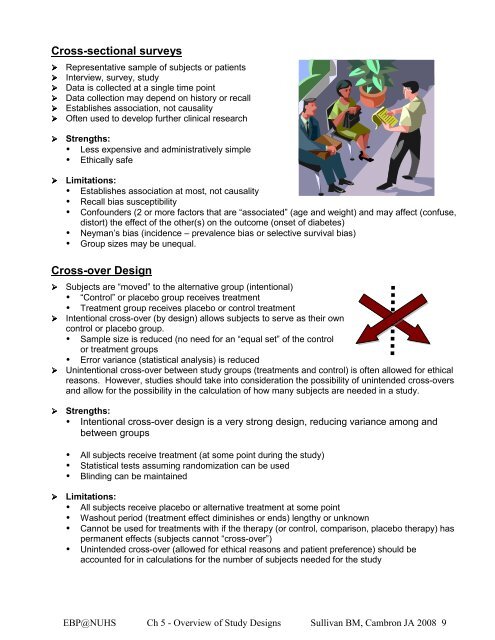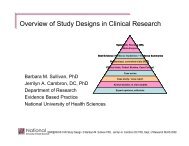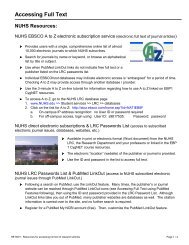Appraising the Literature Overview of Study Designs
Appraising the Literature Overview of Study Designs
Appraising the Literature Overview of Study Designs
Create successful ePaper yourself
Turn your PDF publications into a flip-book with our unique Google optimized e-Paper software.
Cross-sectional surveys<br />
Representative sample <strong>of</strong> subjects or patients<br />
Interview, survey, study<br />
Data is collected at a single time point<br />
Data collection may depend on history or recall<br />
Establishes association, not causality<br />
Often used to develop fur<strong>the</strong>r clinical research<br />
Strengths:<br />
Less expensive and administratively simple<br />
Ethically safe<br />
Limitations:<br />
Establishes association at most, not causality<br />
Recall bias susceptibility<br />
Confounders (2 or more factors that are “associated” (age and weight) and may affect (confuse,<br />
distort) <strong>the</strong> effect <strong>of</strong> <strong>the</strong> o<strong>the</strong>r(s) on <strong>the</strong> outcome (onset <strong>of</strong> diabetes)<br />
Neyman’s bias (incidence – prevalence bias or selective survival bias)<br />
Group sizes may be unequal.<br />
Cross-over Design<br />
Subjects are “moved” to <strong>the</strong> alternative group (intentional)<br />
“Control” or placebo group receives treatment<br />
Treatment group receives placebo or control treatment<br />
Intentional cross-over (by design) allows subjects to serve as <strong>the</strong>ir own<br />
control or placebo group.<br />
Sample size is reduced (no need for an “equal set” <strong>of</strong> <strong>the</strong> control<br />
or treatment groups<br />
Error variance (statistical analysis) is reduced<br />
Unintentional cross-over between study groups (treatments and control) is <strong>of</strong>ten allowed for ethical<br />
reasons. However, studies should take into consideration <strong>the</strong> possibility <strong>of</strong> unintended cross-overs<br />
and allow for <strong>the</strong> possibility in <strong>the</strong> calculation <strong>of</strong> how many subjects are needed in a study.<br />
Strengths:<br />
Intentional cross-over design is a very strong design, reducing variance among and<br />
between groups<br />
<br />
<br />
<br />
All subjects receive treatment (at some point during <strong>the</strong> study)<br />
Statistical tests assuming randomization can be used<br />
Blinding can be maintained<br />
Limitations:<br />
All subjects receive placebo or alternative treatment at some point<br />
Washout period (treatment effect diminishes or ends) lengthy or unknown<br />
Cannot be used for treatments with if <strong>the</strong> <strong>the</strong>rapy (or control, comparison, placebo <strong>the</strong>rapy) has<br />
permanent effects (subjects cannot “cross-over”)<br />
Unintended cross-over (allowed for ethical reasons and patient preference) should be<br />
accounted for in calculations for <strong>the</strong> number <strong>of</strong> subjects needed for <strong>the</strong> study<br />
EBP@NUHS Ch 5 - <strong>Overview</strong> <strong>of</strong> <strong>Study</strong> <strong>Designs</strong> Sullivan BM, Cambron JA 2008 9





